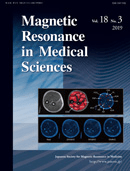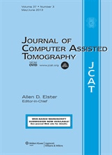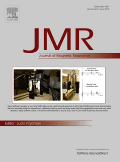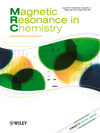
Journal of the Korean Magnetic Resonance Society
Scope & Guideline
Innovating Insights in Magnetic Resonance Science
Introduction
Aims and Scopes
- Nuclear Magnetic Resonance Techniques:
The journal emphasizes the development and optimization of NMR methodologies, including novel techniques and improvements to existing protocols. - Structural Biology and Chemistry:
A significant focus is placed on the structural analysis of biomolecules, including proteins and peptides, utilizing NMR for backbone assignment and interaction studies. - Metabolomics and Bioanalysis:
Research in this area explores the metabolic profiling of biological samples, highlighting the application of NMR in understanding metabolic responses and interactions in various systems. - Natural Products and Marine Chemistry:
The journal publishes studies on the isolation and structural characterization of natural products, particularly those derived from marine organisms, showcasing the utility of NMR in this field. - Theoretical NMR Studies:
Theoretical contributions that enhance the understanding of NMR phenomena and improve experimental techniques are also within the scope, supporting the practical application of NMR in research.
Trending and Emerging
- Protein Dynamics and Interactions:
Recent papers have increasingly focused on understanding protein dynamics and their interactions using advanced NMR techniques, reflecting a trend toward exploring the functional aspects of biomolecules. - Metabolomic Studies of Disease Models:
There is a growing interest in utilizing NMR for metabolomic analyses in disease models, particularly in diabetes and neurodegenerative diseases, indicating the relevance of NMR in biomedical research. - Environmental and Ecological Studies:
Emerging research themes include the application of NMR in environmental and ecological contexts, such as the analysis of natural products from marine sources and their ecological interactions. - NMR in Material Science:
An increase in publications related to the application of NMR in materials science, particularly in studying molecular interactions and structural properties of various materials, is evident.
Declining or Waning
- High-Pressure NMR Applications:
Although high-pressure NMR studies were prevalent in previous years, recent publications show a declining trend in this area, suggesting a possible shift towards more conventional NMR applications. - Theoretical NMR Techniques:
There has been a decrease in the number of papers focused on theoretical advancements in NMR methodologies, indicating that the community may be prioritizing practical applications over theoretical explorations. - Studies on Small Molecule Structures:
Research specifically targeting small molecule structures, while still present, has seen a reduction in frequency, with a growing emphasis on larger biomolecules and complex systems.
Similar Journals

Magnetic Resonance in Medical Sciences
Bridging Science and Medicine Through MRI InnovationsMagnetic Resonance in Medical Sciences is a leading open-access journal published by the Japanese Society of Magnetic Resonance Medicine, dedicated to advancing the field of medical imaging through high-quality research articles and reviews. With a strong focus on radiology, nuclear medicine, and imaging technologies, this journal serves as a crucial platform for the dissemination of innovative studies, as evidenced by its impressive Scopus ranking of #75 in its category and a commendable 77th percentile standing. Since its inception in 2002 and becoming open access in 2016, it has fostered a collaborative research environment, welcoming contributions from both seasoned experts and emerging scholars alike. The journal's commitment to enhancing diagnostic techniques and patient outcomes makes it an invaluable resource for researchers, healthcare professionals, and students passionate about the transformative potential of magnetic resonance imaging. Located in Tokyo, Japan, Magnetic Resonance in Medical Sciences continues to shape the future of medical imaging through rigorous scholarship and impactful research.

Current Cardiovascular Imaging Reports
Illuminating the Path to Advanced Cardiovascular CareCurrent Cardiovascular Imaging Reports, published by SPRINGER, is a notable academic journal within the field of cardiovascular imaging. With its ISSN 1941-9066 and E-ISSN 1941-9074, this journal has been a critical resource since its inception in 2008, aiming to disseminate high-quality research and reviews in the realm of cardiovascular diagnostics and imaging technologies. Though currently categorized within the Q3 and Q4 quartiles for various fields such as Applied Microbiology and Biotechnology, Histology, and Cell Biology, its impact and relevance are growing steadily. Researchers and practitioners can benefit from the insights presented in this journal, especially as it covers advancements and practical applications in cardiovascular imaging techniques crucial for enhancing patient care. Given its ongoing commitment to open access, although not currently available, readers can engage with significant research findings that may inform future studies and applications in cardiology. With plans to converge towards 2024, this journal is poised to facilitate the exchange of knowledge and foster innovation within its dynamic field.

APPLIED MAGNETIC RESONANCE
Empowering Researchers in Magnetic Resonance ApplicationsApplied Magnetic Resonance, published by Springer Wien, stands as a pivotal academic journal within the realm of Atomic and Molecular Physics and Optics. Established in 1990, this journal has become a prominent platform for disseminating high-quality research papers that explore innovative applications of magnetic resonance technologies. With its ISSN 0937-9347 and E-ISSN 1613-7507, the journal is recognized for fostering a deeper understanding of the theoretical and practical aspects of magnetic resonance across various scientific fields. Despite its Q3 ranking in the 2023 Scopus category, it continues to attract a diverse readership interested in advancing the frontiers of physics. Researchers and professionals are encouraged to contribute their findings, as the journal not only enriches academic discussion but also influences real-world applications, making it an essential resource for burgeoning scientists and seasoned experts alike. Additionally, while the journal is not open access, its comprehensive articles can significantly enhance scholarly knowledge and inspire further research in this vital discipline.

Journal of Magnetic Resonance Open
Fostering Collaboration in Cutting-Edge Magnetic Resonance ResearchThe Journal of Magnetic Resonance Open, published by ELSEVIER, is a premier open access journal dedicated to the dissemination of groundbreaking research in magnetic resonance and its applications across various scientific domains. Since its launch in 2019, this journal has carved a niche in the fields of analytical chemistry, electronic, optical, and magnetic materials, as well as radiology and spectroscopy. It holds a commendable position in the academic community, reflected by its 2023 category quartiles, ranking Q2 in both analytical chemistry and electronic materials, and Q3 in radiology and spectroscopy. With an emphasis on open access, Journal of Magnetic Resonance Open provides unrestricted access to research articles, fostering collaboration and innovation. Researchers, professionals, and students will find valuable insights within its pages, contributing to the growing body of knowledge in these dynamic fields, making it an essential resource for staying at the forefront of scientific advancements.

JOURNAL OF COMPUTER ASSISTED TOMOGRAPHY
Illuminating the Path to Advanced Diagnostic TechniquesJOURNAL OF COMPUTER ASSISTED TOMOGRAPHY, published by Lippincott Williams & Wilkins, stands as a vital resource in the field of Radiology, Nuclear Medicine, and Imaging. Since its inception in 1977, this journal has been dedicated to advancing the understanding and application of computer-assisted tomography, emphasizing innovative research and clinical practices that enhance diagnostic imaging techniques. With an impact factor reflective of its rigorous scholarship and relevance—ranking in the Q3 category—the journal serves as an essential platform for contributors and readers alike, navigating the challenges and opportunities within a rapidly evolving field. Researchers, professionals, and students are encouraged to engage with the rich repository of articles that cover emerging technologies, clinical applications, and theoretical advancements, collectively fostering a deeper comprehension of imaging sciences. Although not currently designated as an open-access journal, it continues to enhance discourse in the community from its headquarters in Philadelphia, PA, maintaining a commitment to the highest standards of academic excellence.

JOURNAL OF MAGNETIC RESONANCE
Exploring the Frontiers of Magnetic Resonance ResearchThe JOURNAL OF MAGNETIC RESONANCE, a leading peer-reviewed publication from ACADEMIC PRESS INC ELSEVIER SCIENCE, serves as a vital platform for disseminating cutting-edge research in the fields of biochemistry, biophysics, and condensed matter physics. With an ISSN of 1090-7807 and an E-ISSN of 1096-0856, this journal is committed to publishing innovative studies that explore the principles and applications of magnetic resonance techniques. Ranking in the Q3 and Q2 quartiles across various categories in 2023, it reflects a robust standing within the academic community, especially noted for its contributions to nuclear and high energy physics where it ranks 29th out of 87 journals. The journal's comprehensive scope and emphasis on accessible research make it an essential resource for researchers, professionals, and students alike, facilitating advancements in both theoretical and practical aspects of magnetic resonance. With conversion years spanning 1997 to 2024, the journal continues to uphold its legacy as a cornerstone of knowledge in the best practices of scientific research.

CURRENT OPINION IN STRUCTURAL BIOLOGY
Empowering Scholars with Cutting-Edge Reviews.CURRENT OPINION IN STRUCTURAL BIOLOGY is a premier journal published by CURRENT BIOLOGY LTD that serves as a critical platform for disseminating comprehensive reviews and the latest insights into the field of structural biology. With an impressive impact factor and ranked in the top quartile (Q1) in both Molecular Biology and Structural Biology categories, this journal exemplifies excellence in its scope and academic rigor. Researchers and professionals benefit from its insightful articles that cover cutting-edge developments, methodological advancements, and the implications of structural biology in various biological contexts. As part of the esteemed Current Biology series, the journal is committed to enriching the scientific community's understanding of biomolecular structures and their functions. Based in the United Kingdom and indexed in Scopus with high rankings in multiple relevant fields, CURRENT OPINION IN STRUCTURAL BIOLOGY remains an essential resource for scholars at every stage of their academic journey, from students to seasoned researchers, ensuring the ongoing progress of knowledge in this dynamic field.

MAGNETIC RESONANCE IN CHEMISTRY
Pioneering Research in Chemistry and Materials ScienceMAGNETIC RESONANCE IN CHEMISTRY, published by Wiley, is a prominent journal dedicated to the advancement of knowledge in the field of magnetic resonance as applied to chemistry and materials science. With an ISSN of 0749-1581 and an E-ISSN of 1097-458X, this journal has been an essential resource for researchers since its inception in 1985, maintaining its reputation as a leading publication through its converged years up to 2024. Spanning diverse topics, the journal holds a Q2 quartile ranking in both the Chemistry (miscellaneous) and Materials Science (miscellaneous) categories, illustrating its significance in the academic community. With Scopus rankings placing it in the 61st percentile for General Chemistry and the 55th percentile for General Materials Science, this journal is an esteemed platform for original research, reviews, and critical discussions surrounding magnetic resonance methodologies and applications. As access options are not open, it ensures a curated dissemination of high-quality, peer-reviewed content to support professionals, researchers, and students in their scholarly endeavors.

INTERNATIONAL JOURNAL OF CARDIOVASCULAR IMAGING
Empowering Healthcare Through Cutting-Edge ImagingINTERNATIONAL JOURNAL OF CARDIOVASCULAR IMAGING, published by Springer, is a prestigious platform dedicated to the interdisciplinary field of cardiovascular medicine and imaging. With an ISSN of 1569-5794 and E-ISSN 1875-8312, the journal is recognized in both Cardiology and Cardiovascular Medicine (Rank #154/387, Q2 Category) and Radiology, Nuclear Medicine and Imaging (Rank #137/333, Q2 Category) disciplines, reflecting its significant impact within the scientific community. Established in 1988 and continuing to the present, it provides a rigorous forum for cutting-edge research, reviews, and clinical insights that are essential for advancing knowledge in cardiovascular diagnostics and therapeutic imaging. The journal's dual access options cater to both traditional and open-access readership, ensuring wide dissemination of its findings. In an era where cardiovascular diseases pose a significant public health challenge, the INTERNATIONAL JOURNAL OF CARDIOVASCULAR IMAGING stands out as an essential resource for researchers, healthcare professionals, and scholars aiming to innovate and improve patient outcomes through imaging technology.

Journal of the Korean Magnetics Society
Unveiling the science behind magnetic phenomena.Journal of the Korean Magnetics Society, published by the Korean Magnetics Society, is a prestigious academic journal dedicated to advancing the field of magnetics. Renowned for its contributions to both fundamental and applied magnetics research, this journal spans a wide range of topics, including magnetic materials, magnetometry, and applications in technology. Aimed at researchers, professionals, and students, it serves as a vital platform for disseminating high-quality research and innovative findings within the magnetics community. Although it does not currently offer Open Access options, the journal maintains a high academic standard, supported by its commitment to rigorous peer review processes. Its ISSN 1598-5385 and E-ISSN 2233-6648 ensure that it is easily traceable within academic databases, promoting continuous engagement and scholarship in the disciplines of physics and engineering related to magnetic phenomena. Whether you are looking to publish cutting-edge research or stay abreast of the latest discoveries in magnetics, the Journal of the Korean Magnetics Society is an indispensable resource.